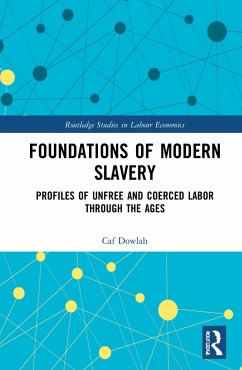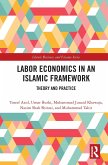- Gebundenes Buch
- Merkliste
- Auf die Merkliste
- Bewerten Bewerten
- Teilen
- Produkt teilen
- Produkterinnerung
- Produkterinnerung
This is an academic inquiry into how labor power has been dehumanized and commodified around the world through the ages for creation of wealth, capital accumulation, and industrialization. It analyses major forms of unfree and involuntary labor markets theoretically and empirically from multidisciplinary and comparative perspectives.
Andere Kunden interessierten sich auch für
![Labor Economics in an Islamic Framework Labor Economics in an Islamic Framework]() Toseef AzidLabor Economics in an Islamic Framework167,99 €
Toseef AzidLabor Economics in an Islamic Framework167,99 €![The Dark Side of Marketing Communications The Dark Side of Marketing Communications]() Tim HillThe Dark Side of Marketing Communications167,99 €
Tim HillThe Dark Side of Marketing Communications167,99 €![The Shadow Economy The Shadow Economy]() Friedrich SchneiderThe Shadow Economy42,99 €
Friedrich SchneiderThe Shadow Economy42,99 €![The Shadow Economy The Shadow Economy]() Friedrich SchneiderThe Shadow Economy118,99 €
Friedrich SchneiderThe Shadow Economy118,99 €![Slavery and Liberation in Hotels, Restaurants and Bars Slavery and Liberation in Hotels, Restaurants and Bars]() Slavery and Liberation in Hotels, Restaurants and Bars185,99 €
Slavery and Liberation in Hotels, Restaurants and Bars185,99 €![The New Geography of Jobs The New Geography of Jobs]() Enrico MorettiThe New Geography of Jobs14,99 €
Enrico MorettiThe New Geography of Jobs14,99 €![Handbook of Research on Unemployment and Labor Market Sustainability in the Era of Globalization Handbook of Research on Unemployment and Labor Market Sustainability in the Era of Globalization]() Handbook of Research on Unemployment and Labor Market Sustainability in the Era of Globalization220,99 €
Handbook of Research on Unemployment and Labor Market Sustainability in the Era of Globalization220,99 €-
-
-
This is an academic inquiry into how labor power has been dehumanized and commodified around the world through the ages for creation of wealth, capital accumulation, and industrialization. It analyses major forms of unfree and involuntary labor markets theoretically and empirically from multidisciplinary and comparative perspectives.
Produktdetails
- Produktdetails
- Verlag: Routledge
- Seitenzahl: 414
- Erscheinungstermin: 30. Juli 2021
- Englisch
- Abmessung: 240mm x 161mm x 27mm
- Gewicht: 784g
- ISBN-13: 9780367749064
- ISBN-10: 0367749068
- Artikelnr.: 62220903
- Herstellerkennzeichnung
- Libri GmbH
- Europaallee 1
- 36244 Bad Hersfeld
- gpsr@libri.de
- Verlag: Routledge
- Seitenzahl: 414
- Erscheinungstermin: 30. Juli 2021
- Englisch
- Abmessung: 240mm x 161mm x 27mm
- Gewicht: 784g
- ISBN-13: 9780367749064
- ISBN-10: 0367749068
- Artikelnr.: 62220903
- Herstellerkennzeichnung
- Libri GmbH
- Europaallee 1
- 36244 Bad Hersfeld
- gpsr@libri.de
Caf Dowlah, a former professor of economics with the State University of New York and the City University of New York for three decades, has most recently been an International Consultant for the Modern Slavery Project of the United Nations. He has also taught at the University of Southern California (his alma mater), the California State University-Fullerton, and the Otaru University of Commerce (Japan). Dr. Dowlah has also worked for the World Bank, the UNDP, the UN-WFP, and the USAID in policy advisory capacities. He has authored over a dozen books and over three dozen papers in refereed journals on international trade, global finance and investment, global value chains, and international labor migration. His latest book- Cross-Border Labor Mobility: Historical and Contemporary Perspectives-was published by Macmillan in 2020. He is also a contributory author to Developing Freedom: The Sustainable Development Case for Ending Modern Slavery, being published by the United Nations.
1. Introduction: The World of Coerced Labor Part I: The World of
Slaveries-Conceptual Contexts 2. Slaveries in the Pre-Columbian World 3.
The Slaveries of Amerindians and Native Americans 4. African Slavery in the
New World Part II: The World of Serfdoms-Conceptual Contexts 5. The West
European Serfdom 6. Eastern European Serfdom 7. The Russian Serfdom Part
III: The World of Feudalisms-Conceptual Contexts 8. The Chinese Feudalism
9. The Japanese Feudalism 10. The Indian Feudalism 11. Latin American
Feudalism Part IV: The World of Indentured Servitudes-Conceptual Contexts
12. Indentured Servitude of the Europeans 13. Indentured Servitude of the
Indians 14. Indentured Servitude of the Chinese Part V: The World of
Guestworkers-Conceptual Contexts 15. The Bracero Program of the United
States 16. Guestworker Programs of Northern and Western Europe 17. The
Kafala System of the Gulf States PART VI: Neoslavery in the Twenty-First
Century-Conceptual Context 18. Neoslavery in the Twenty-First Century-Human
Trafficking 19. Neoslavery in the Twenty-First Century-Global Value Chains
20. Neoslavery in the Twenty-First Century-Assessment of Global Measures to
Combat the Menace
Slaveries-Conceptual Contexts 2. Slaveries in the Pre-Columbian World 3.
The Slaveries of Amerindians and Native Americans 4. African Slavery in the
New World Part II: The World of Serfdoms-Conceptual Contexts 5. The West
European Serfdom 6. Eastern European Serfdom 7. The Russian Serfdom Part
III: The World of Feudalisms-Conceptual Contexts 8. The Chinese Feudalism
9. The Japanese Feudalism 10. The Indian Feudalism 11. Latin American
Feudalism Part IV: The World of Indentured Servitudes-Conceptual Contexts
12. Indentured Servitude of the Europeans 13. Indentured Servitude of the
Indians 14. Indentured Servitude of the Chinese Part V: The World of
Guestworkers-Conceptual Contexts 15. The Bracero Program of the United
States 16. Guestworker Programs of Northern and Western Europe 17. The
Kafala System of the Gulf States PART VI: Neoslavery in the Twenty-First
Century-Conceptual Context 18. Neoslavery in the Twenty-First Century-Human
Trafficking 19. Neoslavery in the Twenty-First Century-Global Value Chains
20. Neoslavery in the Twenty-First Century-Assessment of Global Measures to
Combat the Menace
1. Introduction: The World of Coerced Labor Part I: The World of Slaveries-Conceptual Contexts 2. Slaveries in the Pre-Columbian World 3. The Slaveries of Amerindians and Native Americans 4. African Slavery in the New World Part II: The World of Serfdoms-Conceptual Contexts 5. The West European Serfdom 6. Eastern European Serfdom 7. The Russian Serfdom Part III: The World of Feudalisms-Conceptual Contexts 8. The Chinese Feudalism 9. The Japanese Feudalism 10. The Indian Feudalism 11. Latin American Feudalism Part IV: The World of Indentured Servitudes-Conceptual Contexts 12. Indentured Servitude of the Europeans 13. Indentured Servitude of the Indians 14. Indentured Servitude of the Chinese Part V: The World of Guestworkers-Conceptual Contexts 15. The Bracero Program of the United States 16. Guestworker Programs of Northern and Western Europe 17. The Kafala System of the Gulf States PART VI: Neoslavery in the Twenty-First Century-Conceptual Context 18. Neoslavery in the Twenty-First Century-Human Trafficking 19. Neoslavery in the Twenty-First Century-Global Value Chains 20. Neoslavery in the Twenty-First Century-Assessment of Global Measures to Combat the Menace
1. Introduction: The World of Coerced Labor Part I: The World of
Slaveries-Conceptual Contexts 2. Slaveries in the Pre-Columbian World 3.
The Slaveries of Amerindians and Native Americans 4. African Slavery in the
New World Part II: The World of Serfdoms-Conceptual Contexts 5. The West
European Serfdom 6. Eastern European Serfdom 7. The Russian Serfdom Part
III: The World of Feudalisms-Conceptual Contexts 8. The Chinese Feudalism
9. The Japanese Feudalism 10. The Indian Feudalism 11. Latin American
Feudalism Part IV: The World of Indentured Servitudes-Conceptual Contexts
12. Indentured Servitude of the Europeans 13. Indentured Servitude of the
Indians 14. Indentured Servitude of the Chinese Part V: The World of
Guestworkers-Conceptual Contexts 15. The Bracero Program of the United
States 16. Guestworker Programs of Northern and Western Europe 17. The
Kafala System of the Gulf States PART VI: Neoslavery in the Twenty-First
Century-Conceptual Context 18. Neoslavery in the Twenty-First Century-Human
Trafficking 19. Neoslavery in the Twenty-First Century-Global Value Chains
20. Neoslavery in the Twenty-First Century-Assessment of Global Measures to
Combat the Menace
Slaveries-Conceptual Contexts 2. Slaveries in the Pre-Columbian World 3.
The Slaveries of Amerindians and Native Americans 4. African Slavery in the
New World Part II: The World of Serfdoms-Conceptual Contexts 5. The West
European Serfdom 6. Eastern European Serfdom 7. The Russian Serfdom Part
III: The World of Feudalisms-Conceptual Contexts 8. The Chinese Feudalism
9. The Japanese Feudalism 10. The Indian Feudalism 11. Latin American
Feudalism Part IV: The World of Indentured Servitudes-Conceptual Contexts
12. Indentured Servitude of the Europeans 13. Indentured Servitude of the
Indians 14. Indentured Servitude of the Chinese Part V: The World of
Guestworkers-Conceptual Contexts 15. The Bracero Program of the United
States 16. Guestworker Programs of Northern and Western Europe 17. The
Kafala System of the Gulf States PART VI: Neoslavery in the Twenty-First
Century-Conceptual Context 18. Neoslavery in the Twenty-First Century-Human
Trafficking 19. Neoslavery in the Twenty-First Century-Global Value Chains
20. Neoslavery in the Twenty-First Century-Assessment of Global Measures to
Combat the Menace
1. Introduction: The World of Coerced Labor Part I: The World of Slaveries-Conceptual Contexts 2. Slaveries in the Pre-Columbian World 3. The Slaveries of Amerindians and Native Americans 4. African Slavery in the New World Part II: The World of Serfdoms-Conceptual Contexts 5. The West European Serfdom 6. Eastern European Serfdom 7. The Russian Serfdom Part III: The World of Feudalisms-Conceptual Contexts 8. The Chinese Feudalism 9. The Japanese Feudalism 10. The Indian Feudalism 11. Latin American Feudalism Part IV: The World of Indentured Servitudes-Conceptual Contexts 12. Indentured Servitude of the Europeans 13. Indentured Servitude of the Indians 14. Indentured Servitude of the Chinese Part V: The World of Guestworkers-Conceptual Contexts 15. The Bracero Program of the United States 16. Guestworker Programs of Northern and Western Europe 17. The Kafala System of the Gulf States PART VI: Neoslavery in the Twenty-First Century-Conceptual Context 18. Neoslavery in the Twenty-First Century-Human Trafficking 19. Neoslavery in the Twenty-First Century-Global Value Chains 20. Neoslavery in the Twenty-First Century-Assessment of Global Measures to Combat the Menace








